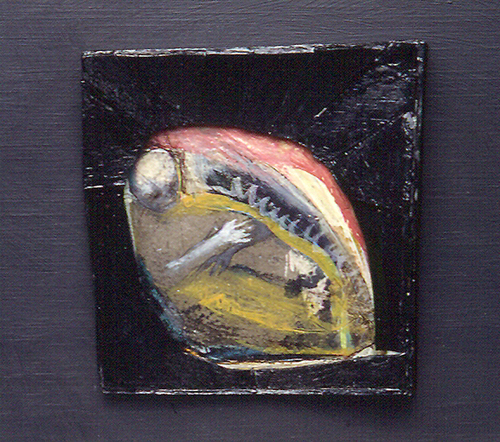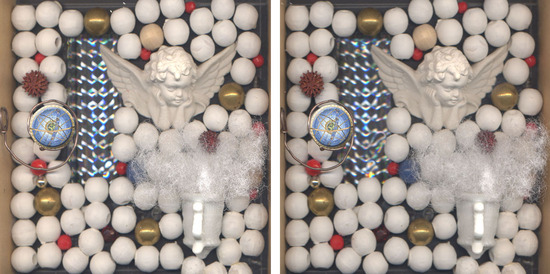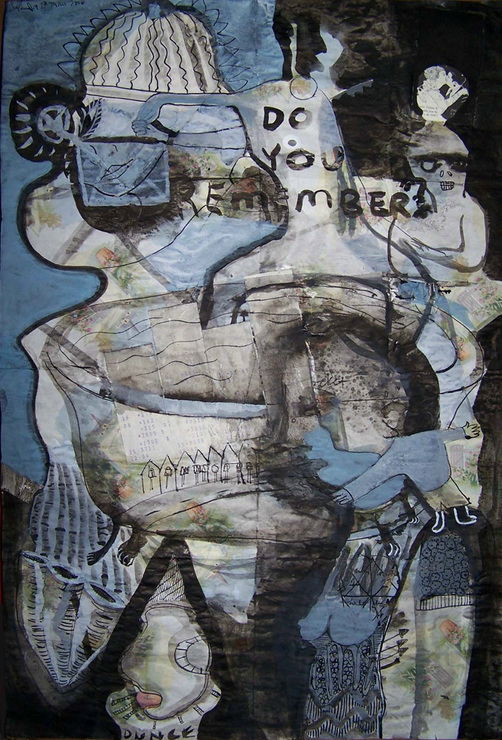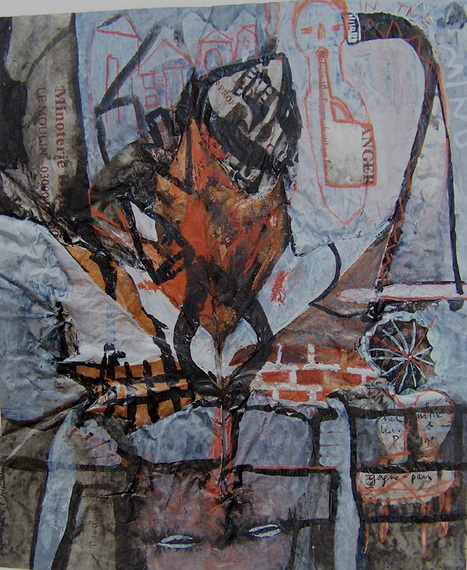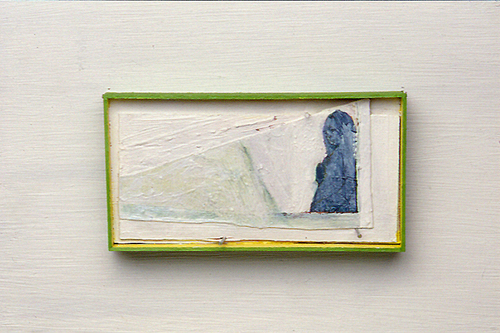the world is bound with secret knots: meditations on curio cabinets and kircher, the dreaming polymath
Athanasius Kircher was born into a shifting landscape of fossils and organic material becoming inanimate, 1602. Dying in 1680, leaving behind traces, a library of books and a museum of engravings and cabinets filled with the magic of his discoveries and inventions. He left the world a more connected place.
"Inside", 5 1/2 x 5 inches, mixed media, 1991 (Private collection), Lisa Salamandra
Being a Kircher novice, I have bought several books about him, and read about him from the points of view of many Kircher scholars. Reading about him and looking at his amazing drawings - of magnetic oracles, botanical clocks, pyramids, luminous maps of the heavens - led me to old museum exhibits and their ancestors, curiosity cabinets.
Cabinets could hold anything: a glass and wood case, with shelves or little boxes, to exhibit a bird's bones, medicine bottles, a doctor's tools, old letters, skulls from small amphibians.
Kircher's main interest, among his polyamorous endeavors in science, philosophy and language, was magnetism: the ruling principle in the world that brought everything into being and kept everything together. His faith that it sustained friendships and brought about love through chemical and alchemical reaction created an underlying skeleton of maps and arteries connecting all of his studies, writings and artistic works. This mysticism is both comforting and unsettling - the mysteries it confronts are the same doubts left unanswered. There is nothing more central to humanism than the trial of the unknown and how we navigate it.
Impossible Rose, Heather Lowe
When I was little, I collected things : rocks from our family trips cross-country, old buttons from my grandmother’s house, matches, postcards, stationery, twigs, branches, leaves, dead flowers, objects with magical significance. Tangible and intangible worlds - connections between inanimate reliquaries and organism.
This was my way to organize facts into being as a child. I thought, this is what I know and this is what I don't know and they became the same.
Heather Lowe, Alchemy
The events of childhood have a tight, organic hold on us - when we’re reminded of them, something uncurls - demons always with us wake up and allows us entrance into secret worlds - a way to see the hidden we bury.
If one’s place is in this, the apparent world, it is also in the world that is not so apparent.
"Daily Bread", 24 x 16 inches, mixed media on the paper wrapped around my
daily bread, 2006, Lisa Salamandra
As an adult, mere collection and organization gives way to organized voyeurism, peering into secret worlds hidden from view. It is only the nakedness of receptivity that allows these worlds to exist. The moveable imagination exists in little furniture, baubles, minerals stuck into little boxes with their clear, black-letter labels: quartz, mica, charcoal.
"Daily Bread", 16 x 13 inches, mixed media on the paper wrapped around my
daily bread, 2002, Lisa Salamandra
Placing objects next to other objects changes their reception - like an antenna for a radio station.
Placement of objects next to similar or dissimilar objects is alchemy. Being near one another changes one’s openness, how one is perceived, and one’s housing.
"Walk", 3 x 5 1/2 inches, mixed media, 1991 (Private collection), Lisa Salamandra
Athanasius’ Atlas: Super locations - are mini locations, shadowboxes, maps, globes with inherent passing of time in their geography. Birds’ nests, seashells, old books with outdated information, all of these settle into code, a way to read the changing lines in the air. From the centuries-future telephone tower, all of these inventions - the botanical clock, magnetic oracle, his tower of babel - intricately connected science and art - nature found in bell wheels and meteorological drawings and renderings, maps of the heavens and lost cultures.

The Awakening, Ken Vallario
Endings are impermanent - every time it seems something ends, it begins again. Those cycles we go through, endings and beginnings, are encapsulated in a hidden box of sundials and microscopes. Cabinets and fashioning resting places, little gravesites, for objects is pinning time down to a piece of labeled paper, an insect already dead but with living properties. Curiosities in a constricted space turn into something else - a fixed point in time, enduring all the back and forth and suffering of time passing and impermanence. Although the exhibit is permanent and occupies a fixed space, it holds no more stability than a chemical compound changing from solid to gas to liquid and back again.
What is left behind is left behind in vials.

Dice, Ken Vallario
Kircher's plate entitled, "The World Is Bound with Secret Knots" says it all. It features a hand coming out of clouds in the sky, holding a circular link in a chain connecting an angel, a book, three circular seals, and leading down to the ground, and then going underground, to a series of strange, interlocking rooms of earth.
What is left behind is left behind in vials.
- Arielle Guy
Artists:
Lisa Salamandra's work can be found at lisasalamandra.com.
Ken Vallario's work can be found at kenvallario.com.
Heather Lowe's work can be found at geocities.com/heatherjlowe.






